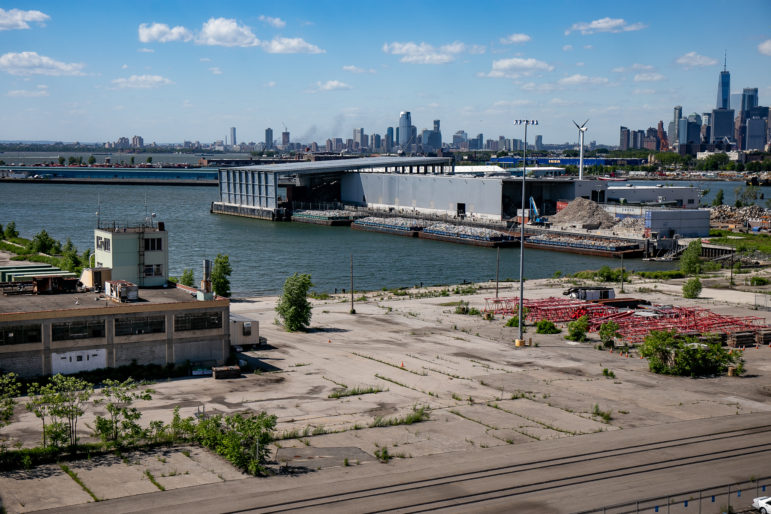‘The Biden Administration is making $3 billion available to port facilities throughout the country that support the wind industry. New York City is a prime candidate to receive federal investment as we are already preparing a 72-acre site at the South Brooklyn Marine Terminal for such activity.’

Adi Talwar
The South Brooklyn Marine Terminal in Sunset Park, where the EDC is planning offshore wind infrastructure.Building a city that is more resilient in the face of climate change and plotting a future for green energy are imperatives for New York City. That is why we are investing millions of dollars and planning hours to grow an offshore wind hub, to create local training programs and pipelines for green jobs and construct much-needed protections for our coastlines and our residents.
Since 2018, New York City Economic Development Corporation has been preparing New York City to be a regional hub for offshore wind staging and installation. We see our support for producing clean power as essential for the city’s health and longevity, and to its long-term recovery and reemergence following COVID-19. Bold action to fight this global problem will establish New York as a world-leader and demonstrate how this type of work can be rooted in equity and local benefit. With such a nascent industry, we have an opportunity to shape it from the outset and be a model for how to bring the community into the process.
A few weeks ago, the Biden Administration specifically identified the New York-New Jersey area as a place to grow the offshore wind industry, making $3 billion available to port facilities throughout the country that support the industry. New York City is a prime candidate to receive federal investment as we are already preparing a 72-acre site at the South Brooklyn Marine Terminal for such activity. Just this week we joined Congressmembers Nydia Velasquez and Jerry Nadler at the site urging the federal government to make continued investments in supporting the wind industry here in New York City.
 CityViews are readers’ opinions, not those of City Limits. Add your voice today!
CityViews are readers’ opinions, not those of City Limits. Add your voice today!
Within the next few years, we will directly service the production of 3.3 gigawatts of clean energy on the site. We are especially proud of the commitments our partner, Equinor US, has made related to future operations on this site. Specifically, they will establish a $5 million fund to support growing the talent pipeline locally, invest in local programming, and ensure there are community initiatives in place to support low-income New Yorkers in the green energy transition. We will also target a high Minority- and Women- Owned Business Enterprise (MWBE) participation goal of 30 percent, and support capacity-building and technical assistance for local businesses. Another goal is to minimize carbon emissions on site to further protect the environment.
Investing in renewable energy will help stem the rise of sea levels, but we also must protect and fortify the city now. This is not an easy task. It takes vision and it takes the collective knowledge of scientists, engineers, architects, city planners, residents, and businesses to come together in public-private partnerships to do what is best to secure our city for future generations. NYCEDC is uniquely experienced to make this happen. In 2012, Hurricane Sandy smashed onto our shores. It caused the deaths of more than 40 people in New York alone and $19 billion in citywide damages and lost economic activity. We never want to see this devastation again, which is why we have invested billions in resiliency projects across all five boroughs.
Our Lower Manhattan Coastal Resiliency Initiative (LMCR) includes a series of measures along the southern tip of Manhattan that will raise and protect some of our most vulnerable land and residents from destructive flooding. The initiative includes investing over $500 million in projects that will be under construction within the year. That list includes the redesign of a popular pedestrian esplanade as part of the Brooklyn Bridge Montgomery Coastal Resiliency (BMCR) project. BMCR ensures the local community can continue to enjoy waterfront access with recreational features that can be transformed into critical protection during major flooding events.
The more long-term elements include the Financial District and Seaport Climate Resilience Master Plan, a process launched in 2019 to design infrastructure that responds to the unique constraints and climate hazards facing those neighborhoods. The result will be an enhanced and protected waterfront, complete with an accessible public space. That waterfront access will connect to maritime infrastructure and critical modes of transportation, which New Yorkers from every community rely on to get to work or simply grab a breath of fresh air. As we always do, we are bringing the community in early and often and have made residents and equity key values in the envisioning process to protect the district.
In all these sustainability projects, we will need more than just our vision. We need the continued support of President Biden, of Senate and Congressional lawmakers, of our local planners, and environmental justice advocates. We need to continue to focus on far-reaching initiatives for infrastructure that not only improves our parkland and streetscapes but protects them. We know that producing clean energy cannot wait. We know that the next one-in-a-hundred-year storm is coming, and we cannot afford to be unprepared. Today we are taking significant action to protect and fortify our city for the future while creating renewable energy and focusing on environmental justice to secure a healthier and fairer New York for generations to come, and we welcome partners to do the same.
Rachel Loeb is acting president of New York City Economic Development Corporation.








